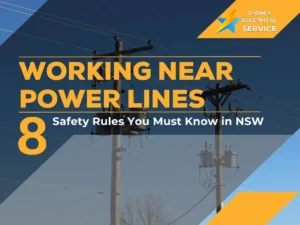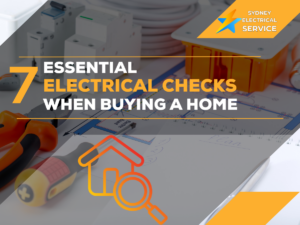Google Reviews ⭐⭐⭐⭐⭐

Can you imagine living without electrical appliances? Our electric ovens, washers and dryers, and lights are all essentials of modern convenience. But with great power comes great responsibility, and an electrical emergency can pose severe risks to you and your loved ones.
From electrical fires to power outages, electrical emergencies can arise from numerous hazards. But don’t worry. In this article, we’ll be sharing the most common electrical emergencies you might face and suggest smart actions you should take to deal with them. So, buckle up and let’s dive right in.
TYPES OF ELECTRICAL EMERGENCIES
Here are the most common types of electrical emergencies:
1. ELECTRICAL FIRES
Electrical fires happen quite often. They usually result from problems with either the electrical system or faulty appliances, and they can be really harmful. In order to reduce the chance of electrical fires, make sure to get your electrical panels and systems checked regularly.
2. POWER OUTAGES
We frequently encounter power outages, also known as power failures or blackouts. These disruptions can happen for various reasons and pose both safety risks and considerable inconvenience.
3. ELECTRIC SHOCKS
Our bodies are like electrical conductors, so if you ever get shocked, the electricity can move through your whole body. This can put your well-being at risk. Electrical shocks come in different strengths. Some you might hardly feel, while others last longer.
But the results can range from minor problems like skin burns to more serious issues such as heart damage or, in extreme cases, even complete heart failure. Therefore, it is really important to know about these potential dangers so you can make your safety a top priority.
HOW TO TACKLE AN ELECTRICAL EMERGENCY?
In case you encounter an electrical emergency, it is crucial to know how to handle the situation to avoid any potential harm. Therefore, it is essential to educate yourself on how to handle an electrical emergency before a situation arises.
1. AVOID CONTACT WITH SOMEONE RECEIVING AN ELECTRIC SHOCK
If someone you know, whether it’s a family member, friend, colleague, or even a stranger, experiences an electrical shock, it is natural to want to help immediately. However, it is important to be cautious, as your well-intentioned actions could potentially worsen the situation.
In the event of an electrical shock, resist the instinct to touch the person, as the current could pass through you. That can make matters worse. In some cases, people might appear stuck to the source of the shock due to muscle contractions caused by high voltage.
That’s why it is crucial to keep a safe distance between yourself, the person in distress, and the electrical source. Additionally, be aware of any water in the area, as water is an excellent conductor of electricity.
While waiting for professional help to arrive, take extra precautions when moving around the area to avoid any potential risks. Remember, prioritizing safety and being mindful of the dangers associated with electrical shocks can make a significant difference in ensuring the well-being of everyone involved.
2. CALL EMERGENCY SERVICES AS SOON AS POSSIBLE
Ideally, if you have someone with you, coordinate with them. However, in the absence of assistance, it is crucial to promptly call emergency services. Victims of severe electric shocks require professional medical treatment, so receiving a team of emergency responders should be your immediate priority before attempting any further intervention.
When making the emergency call, provide as much information as possible about your location and the incident. This detailed information enables the emergency crew to prepare adequately during the route.
3. TURN OFF THE POWER
If the situation allows, turn off the main power source to enhance the safety of the area and potentially avoid additional electrical issues. However, ensure you switch off individual branches before the main circuit breaker to safeguard your appliances.
If someone is undergoing an electrical shock and you can’t safely cut the power, attempt to separate the person from the source of the shock using dry, non-conductive materials. This could be something like a wooden broomstick or a rescue tool from a low-voltage rescue kit if you have one nearby.
4. USE A FIRE EXTINGUISHER
Fire extinguishers can certainly help overcome electrical emergencies. Therefore, it is important to have a fire extinguisher within reach and to be familiar with its operation. Fortunately, using a fire extinguisher is quite simple. Just pull the pin, depress the handle, and, before holding down the handle, aim the horn in the fire’s direction. Continue this process until the fire is fully extinguished.
If you can’t cut the power causing the electrical fire, opt for a Class-C rated fire extinguisher, typically carbon dioxide or dry chemical-based. This is because these extinguishers can effectively put out electrical fires. On the other hand, if you manage to cut the power, you can safely use a Class A extinguisher, which is water-based.
END NOTE
Dealing with electrical emergencies requires a blend of caution, alertness, and prompt action. Recognizing common issues like electrical fires, power outages, and shocks empowers individuals to respond effectively.
Remember, when dealing with an electrical shock, resist the instinct to touch the person and prioritize calling emergency services. Turning off the power when safe and utilizing a fire extinguisher are critical steps in managing potential hazards.
Staying informed about electrical safety, conducting regular system checks, and understanding how to use safety equipment can significantly contribute to a safer living environment. By promoting awareness and taking decisive measures, we can mitigate the risks associated with electrical emergencies. And ensure the well-being of ourselves and those around us.
FAQs:
WHAT PERSONAL PROTECTIVE EQUIPMENT (PPE) IS USED IN ELECTRICAL SAFETY?
Personal Protective Equipment (PPE) plays a crucial role in electrical safety. The following are common PPE items used:
- Insulated Gloves: Protect hands from electric shock.
- Safety Glasses or Face Shields: Shield eyes from potential sparks or debris.
- Flame-Resistant Clothing: Minimize the risk of burns in case of a fire.
- Hard Hats: Guard against falling objects or overhead hazards.
- Insulated Tools: Prevent conductivity and potential shock.
- Ear Protection: Shield ears from loud noises in electrical environments.
WHAT IS THE IMPORTANCE OF STAYING ALERT IN ELECTRICAL WORK?
Staying alert is the key to preventing severe consequences during an electrical emergency. It helps deter accidents and enhances overall safety in electrical environments.












